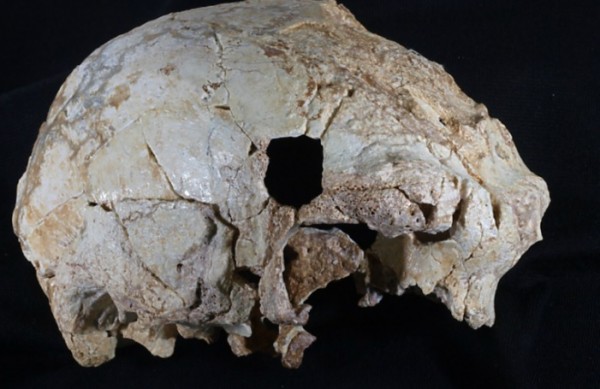By Ana Verayo, | March 15, 2017

This cranium belongs to a Neanderthal from more than 400,000 years ago in Portugal.
In an astonishing discovery, researchers were able to uncover an ancient human skull in Portugal dating back to 400,000 years. Scientists also suggest that this specimen could belong to the oldest human ancestor in the country.
This ancient skull was discovered inside Aroeira cave that is also filled with other fossilized remains from animals. Some of the skeletal fossils were also found burnt or charred where various stone tools are also found along with handheld axes. Researchers consider this cave as a treasure trove and could be considered as the earliest evidence of stone tool use in European history.
Like Us on Facebook
The cranium appears to be very well preserved where the skull was found within sedimentary rock from around 436,000 years ago during the mid Pleistocene period. Researchers were able to carry out excavations and unearthed a total of 367 stone tools and 180 flaked stones that are thought to be waste or excess material that have been shed in shaping blade tools.
The manner in which the charred remains were found inside the cave along with the skeletal fossils and tools suggests that this European human ancestor was attempting to create fire to cook meat while using stone tools, to kill prey and prepare it. Apart from this, the skull also possessed several Neanderthal features that provide crucial clues about the early evolution of Neanderthals including how they diverged and spread across the continent.
These new findings also present that prehistoric humans living in southwestern Europe have already developed stone tool craft with the use of fire where this technology rapidly spread out across the continent.
According to author of the study, biological anthropologist Rolf Quam from Binghamton University, the State University of New York, this Aroeira cranium is the oldest ever human fossil found in Portugal. This also shares some important traits with other fossils found in France, Spain and Italy during the same time period.
Quam explains, this skull discovery also shows that there is greater anatomical diversity among the human fossil record during this time period. This also suggest how different populations also possessed different combinations of traits and features. This new study is published in the journal PNAS.
-
Use of Coronavirus Pandemic Drones Raises Privacy Concerns: Drones Spread Fear, Local Officials Say

-
Coronavirus Hampers The Delivery Of Lockheed Martin F-35 Stealth Fighters For 2020

-
Instagram Speeds Up Plans to Add Account Memorialization Feature Due to COVID-19 Deaths

-
NASA: Perseverance Plans to Bring 'Mars Rock' to Earth in 2031

-
600 Dead And 3,000 In The Hospital as Iranians Believed Drinking High-Concentrations of Alcohol Can Cure The Coronavirus

-
600 Dead And 3,000 In The Hospital as Iranians Believed Drinking High-Concentrations of Alcohol Can Cure The Coronavirus

-
COVID-19: Doctors, Nurses Use Virtual Reality to Learn New Skills in Treating Coronavirus Patients







